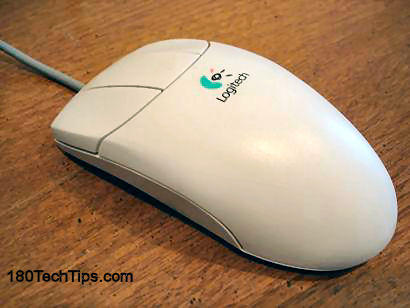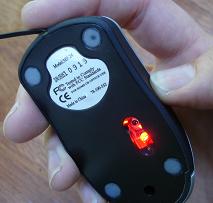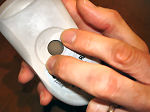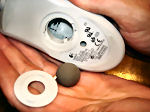Technology Tip Number 1
Password Pandemonium
Password Pandemonium
Good Passwords and Bad Passwords? Here’s a website that specifically lists “bad” passwords. http://geodsoft.com/howto/password/common.htm. If someone wanted to “crack” your password using computer software they would probably check all of these kinds of passwords first. For the dedicated “password cracker” there are actually huge lists of common passwords available online. Here's a link to more information about how passwords are cracked: So what makes for a good password? Here are some basic suggestions but in the end it will be up to you to come up with something that works for you:
1) Avoid common names, dates, phone numbers or things easily associated with you.
2) Avoid common words or phrases as they would be the first thing checked by password cracking software.
3) Use a combination of numbers and letters. For example, substitute numbers for letters and letters for numbers in a word or phrase.
4) Make it something you can remember all by yourself. Don’t write it down anywhere!
5) Don’t use naturally occurring keyboard sequences (like “qwerty” for example)
6) Try to make it at least 8 - 16 characters long. Obviously the longer the better.
7) Plan on changing your password often. Experts suggest changing your passwords at least every 6 months.
Whether it’s about protecting the money in your bank account or just accessing your email online, you’ll need to have good usernames and passwords to protect yourself. Choose wisely.
And if you're still having trouble coming up with a password, here's an easy to use random password generator:
Technology Tip Number 2
Take a Picture of Your Screen
Take a Picture of Your Screen
Simply press CTRL and Print Scrn/SysRq
in the upper right hand corner of your keyboard:
in the upper right hand corner of your keyboard:
You have now taken a picture of your screen. Now you could open a blank email and paste it in by pressing CTRL and the letter V at the same time.
(hint taking screen shots like this and then editing them in a simple program like Paint is how we make the directions in many of these Technology Tips)
PRACTICE ACTIVITY: Try emailing a screen shot of your desktop to yourself today. If that doesn't work try pasting a screen shot of your desktop into a blank word document and print it out.
TO KEEP ON LEARNING: If you'd like to learn more about using Microsoft Windows and making screenshots try searching the internet for:
Windows Tutorials
Screenshots tips and tricks
Screenshots tips and tricks
Technology Tip Number 3
Common Cables & Connectors
USB connections: Probably one of the biggest innovations in computers in a while, USB (Universal Serial Bus) connectors are being used for all kinds of things these days. The kinds of things you can plug into those ports: your mouse, your keyboard, the cable for a digital camera, even your USB drive (like the SanDisk thumb drive in the picture, on the right).
In this picture you can see an older mouse with what’s called a PS/2 connection (on the left) and a newer one with a USB connection (on the right). You could use either style mouse with your computer if it's newer.
S-Video Cable is often used to connect DVD players and TV’s. These newer cables are supposed to offer better video quality and more distance. If you have a scan converter (AverKey) you might be using S-Video cable to connect it to your TV.
SVGA Cable is the one that connects your monitor and computer together. If you ever have to disconnect and reconnect one of these be real careful not to bend any of the little prongs in there.
Digital Camera to TV Adaptor – Most newer digital cameras come with one of these. You could use this to display pictures on the digital camera to the TV.
Surge Protectors and Power Cables – Yes you should have a surge protector on your computer. Computers are very sensitive to sudden fluctuations in power and a surge protector
Not enough information? Looking for the proper name for some dusty old cable you just found under your desk? Try this website for more information:
PCCables.com - Cable Finder
: Check the connections on your own computer today. Make sure you have some idea where all the wires go incase you ever have to check them in the future.PCCables.com - Cable Finder
can help. Its also a much safer way to multiply the number of outlets in a room as most surge protects also have a fuse in them that will trip (shut down) if you draw too much current. HELPFUL HINT: If your computer suddenly stops working don’t forget to check the surge protector.
TO KEEP ON LEARNING: If you'd like to learn more computer cables and connectors try searching the internet for:
Common computer cables
computer acronyms
computer acronyms
Technology Tip Number 4
Improving Your PowerPoint's
Improving Your PowerPoint's
Have you ever lost something you saved to a disk? Ever had your home computer crash? Pretty annoying to lose everything isn’t it? Here’s a way to save files so they are accessible anywhere in the world without carrying a disk around or saving them to your computer.
Let’s say you’re at the Community College Library typing your doctoral thesis and you decide you want to save it to work on later. Oops, you forgot to bring a disk or a flash drive with you. How are you going to save it?
Just Email it to Yourself:
We're starting to see students do this more and more. All you have to do is access your work email via the internet (sometimes this is called called webmail). If you don't have a webmail address you can get a free one at: http://www.hotmail.com Once you have accessed your webmail you would:
We're starting to see students do this more and more. All you have to do is access your work email via the internet (sometimes this is called called webmail). If you don't have a webmail address you can get a free one at: http://www.hotmail.com Once you have accessed your webmail you would:
- Start a new email (
) and put your own email address in the "TO:" line.
- Attach the file you want to email to yourself by clicking on "Attach" or the paper clip symbol
- Then just click "Send" and the email will be sitting in your inbox waiting for you with your paper attached. You can log onto your webmail and access it anytime from anyplace in the world where you have the internet.
By emailing something to yourself you are essentially storing it in cyberspace until you need it. You don't have to carry it around on a disk or worry about loosing the hard copy. It just sits there in your email inbox waiting for you.
Keep in mind that many of our students know how to do this. When they ask you if they can access their email while in class they might just be trying to access their homework so they can print it out.
PRACTICE ACTIVITY: Try emailing yourself a copy of an important file you have saved on your computer. That way you’ll always have a back-up of that file waiting for you in your email in-box.
TO KEEP ON LEARNING: If you'd like to learn more about using email creatively try searching the internet for:
Here are some very reasonable guidelines for PowerPoint Presentations (they are the same ones we stress for 7th graders for reference):
1) Use the same background for all the slides. When in doubt use one of the Design Templates that came with PowerPoint. These templates guarantee a professional looking background every time. You can find even more premade templates on the Microsoft Office Website .
2) Pick High Contrast colors. High contrast means light letters on a dark background for example. High contrasting colors makes it much easier to read the slides. When in doubt use one of the Design Templates that came with PowerPoint. This guarantees high contrast colors.
3) Use one good picture or graphic per slide. PowerPoint is a visual medium so please use pictures and graphics. Just make sure the pictures are relevant to the topic and large enough for the audience to see and appreciate them. Search online for free images.
4) Minimum of 32 pts for the font size. Remember you’re making a presentation and not an eye exam. Your audience should be able to read the slides without binoculars.
5) Maximum of 5 lines of text per slide. Use bullet lists and phrases rather than whole sentences. Plan on explaining the bullets and phrases as part of your oral presentation.
6) Please don’t read the slides to your audience. Generally speaking, all the members of your audience are literate. Instead of reading the slides to them use the slide as a launching point to tell them more about your topic.
Technology Tip Number 5
Just Googling Around
Just Googling Around
The internet is big, really, really big, and if you want to use it effectively you have to be familiar with search engines. Google.com has become the search engine of choice for millions of internet users. There are others and if the past is any guide there will be a “better than Google” search engine some day, but for now Google seems to be the best. Part of the reason they are the best is that they keep developing new ways of looking at the internet. Below are a couple additional features that Google offers that you might want to check out now and in the future as they continue to develop:
http://news.google.com/ Need a current event? Forget about the newspaper, use the internet like teenagers do to find stories that are only minutes old.
http://images.google.com/ Arguably the best image search engine in the world. Try finding a picture of something today.
http://www.google.com/products Looking to make a purchase. Shop and compare prices online first using Google's Product Search.
http://www.google.com/finance What to check the stock market, try this website for a quick overview.
http://maps.google.com/ Looking for an up to date map or satellite photo, check out these amazingly easy to manipulate maps and photos.
http://video.google.com/ Google has their own video search engine. Find an educational video on the internet that you can play for your class
http://scholar.google.com/ Another project that Google is working on is to create a more efficient way to search scholarly papers.
http://books.google.com/ This is a great way to jump into some literature. Check out a book online, read some passages and find out where you can buy a copy.
PRACTICE ACTIVITY: Just try out any of the webpages above to find something. Find directions for a vacation destination, look for educational videos, shop for new classroom or work gadgets, check out the news.
TO KEEP ON LEARNING: If you'd like to learn more about Google try searching the internet for:
Technology Tip Number 6
Your Computer Mouse

 If you have a newer computer mouse you probably have an optical mouse. These mice are much more reliable since they have no moving parts and will work on just about any surface.
If you have a newer computer mouse you probably have an optical mouse. These mice are much more reliable since they have no moving parts and will work on just about any surface.
Your Computer Mouse
The ubiquitous mouse has become one of the most important and effective tools for interacting with the computer. There are a couple different kinds of computer mice but they all pretty much do the same thing. They move the pointer around the screen so you can select different things.
Clicking and Double Click is not only hard to explain but at first it's pretty hard to do too. Here's is a great website that can help you practice this important skill: There is also an activity at that website to help you practice Clicking and Dragging.
If you have an older computer mouse it probably works on a track ball which is located under the mouse. Occasionally this track ball will get dirty and your mouse pointer will skip around the screen randomly. 
 When this happens you can easily fix it by opening the bottom disc that holds the track ball in and then removing any foreign objects that might be causing the mouse to behave erratically.
When this happens you can easily fix it by opening the bottom disc that holds the track ball in and then removing any foreign objects that might be causing the mouse to behave erratically.

 When this happens you can easily fix it by opening the bottom disc that holds the track ball in and then removing any foreign objects that might be causing the mouse to behave erratically.
When this happens you can easily fix it by opening the bottom disc that holds the track ball in and then removing any foreign objects that might be causing the mouse to behave erratically.